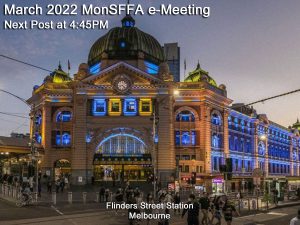All posts by Keith Braithwaite
Post 8 of 8: Thank You, Wrap-Up, Next e-Meeting Date
 This is our meeting-closing post.
This is our meeting-closing post.
12) THANK YOU!
We’d like to extend a big thank-you to our special guest this afternoon, Lonny Buinis, and tip our hats, as well, to Joe Aspler, Keith Braithwaite, and Cathy Palmer-Lister for their contributions to today’s programming. We also thank all supporting contributors to this, our April 2022 e-meeting.
And of course, to those who visited with us this afternoon, and took in our online get-together, thank you for your interest and attention, and don’t forget to comment on today’s confab.
13) WRAP-UP (SIGN-OFF)
We sincerely hope you have enjoyed your time with us these past few hours, we again thank you for dropping in, and we ask that you pop in regularly here at www.MonSFFA.ca for additional content during this maddeningly persistent pandemic. Check, too, for any updates as to when the club expects a return to regular, face-to-face meetings.
Enjoy your chocolate eggs and bunnies next weekend, and keep well.
14) CLUB’S NEXT ONLINE MEETING DATE
We will again convene right here at www.MonSFFA.ca on Saturday, May 14, for another in our ongoing series of MonSFFA e-meetings!
Post 7 of 8: Show-and-Tell, Answers to Quickie Quiz
This is Post 7 of 8.
10) SHOW-AND-TELL
For those participating on ZOOM, today, we open the floor to any club members who have “fancraft” projects to showcase—sci-fi scale models, SF/F woodworking or needle crafts, whatever genre-themed, hands-on project it may be that you are currently working on, or have recently completed.
Those not able to join our ZOOM chat for this show-and tell may, at this time, review the following:
11) ANSWERS TO QUICKIE QUIZ
Here are the answers to the Quickie Quiz we posted at the outset of today’s meeting (see Post 1 of 8). How many titles did you remember correctly?
1) What was the title of that old science fiction anthology series produced back in the 1950s, I think it was? You know, the one that began each episode with the host demonstrating a simple science experiment which was related to that week’s episode!
Science Fiction Theatre (1955-1957) was an anthology series produced by science fiction movie director/screenwriter Ivan Tors and hosted by radio/television announcer and 1940s film actor Truman Bradley.
The show put an emphasis on the “science” in “science fiction,” offering “what if” extrapolations rooted in known scientific fact. Stories involved space flight, time-travel, robots, flying saucers and extraterrestrials, mental telepathy, and more. Each episode opened in a laboratory replete with a variety of scientific instruments where Bradley conducted a quick science experiment for the audience, one which related to the fictional story about to be presented.
The series came out of the ZIV company, an American producer of episodic television programs for first-run syndication in the 1950s. Science Fiction Theatre was a forerunner of later, better known shows like The Twilight Zone and The Outer Limits, and was retitled Beyond the Limits for another syndicated run in the 1960s, airing, as well, on PBS and the Sci-Fi Channel in later decades.
2) What was the title of that classic Star Trek episode, the one where Captain Kirk delivers a stirring speech about risk?
“Return to Tomorrow” (1968), a second-season episode penned by John T. Dugan, writing as John Kingsbridge. Diana Muldaur guest-starred as crewmember Dr. Ann Mulhall; the actress would appear again as Dr. Miranda Jones in the show’s third-season episode “Is There in Truth No Beauty?” As well, she joined the season-two cast of Star Trek: The Next Generation (1987-1994), playing chief medical officer Dr. Katherine “Kate” Pulaski, departing after the season concluded. Muldaur, it seems, has a penchant for playing doctors on Star Trek!
The Enterprise responds to a distress call and on an otherwise lifeless planet finds the incorporeal minds of “fantastically advanced” aliens Sargon, Henoch, and Thalassa housed within disco balls in a subterranean chamber. Leader Sargon requests of Kirk that the three beings be permitted to temporarily inhabit the bodies of the captain, Spock, and Dr. Mulhall so that they may construct android bodies for themselves, after which the borrowed bodies of the Enterprise personnel would be returned. Kirk feels that he can trust Sargon and despite the “enormous danger potential” involved, champions the idea, delivering in support of the proposal one of Star Trek’s finest inspirational orations—“Risk. Risk is our business. That’s what this starship is all about. That’s why we’re aboard her.”
But Henoch has an idea of his own!
James “Scotty” Doohan provided the voice of Sargon.
3) What was the title of that 1960s science fiction/horror movie featuring an exotic, green-skinned alien woman who turns out to be a vampire?
Queen of Blood (1966), also known as Planet of Blood, was said by the film’s writer/director, Curtis Harrington, to have inspired, to some degree, Ridley Scott’s Alien (1979). “Ridley’s film is like a greatly enhanced, expensive and elaborate version of Queen of Blood,” he professed in an interview.
In the far-flung future of 1990, an alien race has contacted mankind and are sending an ambassador to Earth.
When a strange, green-skinned woman whose spaceship has apparently crashed on Mars is found unconscious, she is taken aboard a rescue ship dispatched from Earth. Regaining consciousness, she smiles tantalizingly at the Earthship’s three male crewmembers, but frowns at the only female astronaut aboard.
The strange woman soon entrances, attacks, and kills one of the men, then later another, draining them of their blood. Finally, the female crewmember interrupts her attempt to kill and feed upon the third crewman, grappling with the vampiric alien, who succumbs screaming to a mere scratch inflicted upon her during their struggle.
It is deduced that she was a hemophiliac. Further, her eggs are found hidden about the ship, leading to the conclusion that she was the bee-like queen of her people and had been sent to Earth not as an ambassador, but to secure fresh feeding grounds and breed.
Czech-born French film actress Florence Marly played the Queen of Blood, and the eclectic cast included John Saxon, Dennis Hopper, Judi Meredith, Basil Rathbone, and Forrest J Ackerman. Special effects footage was lifted from the Soviet SF films Mechte Navstrechu and Nebo Zovyot, respectively in English, A Dream Come True and Battle Beyond the Sun. The story was derived from Mechte Navstrechu’s screenplay. Roger Corman, though uncredited, was behind the project.
4) And then there was another science fiction/horror picture I remember seeing many years ago, with Hammer stars Christopher Lee and Peter Cushing. You know, the one where a frozen, primeval monster discovered in a cave is being transported to Europe on the Trans-Siberian Express. The creature awakens and begins picking off passengers one by one! What was the name of that one, again?
Horror Express (1972), a Spanish/UK co-production featuring Lee and Cushing, in addition to Telly “Kojak” Savalas as a Cossack officer. Eugenio Martin conceived of the story and directed.
As was common practise at the time, Spanish- and Italian-made films were shot silent, with the cast’s voices and sound effects added in post-production. The English-speaking players provided their own voices, here, while other performers dubbed those of Argentinian actor Alberto de Mendoza and Spanish actress Silvia Tortosa.
Lee plays a renowned English anthropologist who is transporting to Europe by rail the frozen remains of a primitive humanoid creature he has discovered. He hopes his find will prove to be a missing link in the story of human evolution. But the creature thaws and escapes its crate, and the bodies soon begin to pile up aboard the train. Cushing is Lee’s friendly rival and the two soon determine that the humanoid creature had been taken over by an ancient, amorphous extraterrestrial entity that robs its victims of their memories and knowledge. When a police inspector shoots the creature, the alien entity jumps hosts, now inhabiting the inspector. And so begins the real threat to everyone aboard the train!
Horror Express is at the heart of a 2021 episode of Shudder’s revived Creepshow series, wherein an inventor creates a VR system that allows him to immerse himself within any movie he wishes. Horror Express happens to be his favourite film, and he visits the setting often, interacting with the Lee and Cushing characters, and romancing Silvia Tortosa’s beautiful Countess Irina, much to the chagrin of his actual wife!
5) What was the title of that Saturday-morning sci-fi show about young cadets attending a space school built on an asteroid? The old guy from Lost in Space was their commander!
Space Academy (1977) was a short-lived live-action children’s television program produced by Filmation, a studio better known for decades of Saturday-morning cartoon series like Star Trek: The Animated Series (1973-1974) and He-Man and the Masters of the Universe (1983-1985).
Lost in Space star Jonathan “Dr. Zachary Smith” Harris headlined the cast as Commander Gampu, head of Space Academy, a school built on an asteroid in the “star year” 3732. Here, young students from across the known worlds were trained to face the challenges of darkest space.
The show’s featured spacecraft were dubbed “Seekers,” and a catchphrase unique to the series was “ORACO,” shorthand for “Orders Received and Carried Out.”
Special effects, meanwhile, were quite serviceable for Saturday-morning fare and viewers were taught a moral lesson with each half-hour episode, of which there were a total of 15.
6) What was the name of that Thunderbirds episode where an attempt to jack up and move the Empire State Building goes catastrophically wrong, requiring the involvement of International Rescue?
“Terror in New York City” (1965), in which the incredible engineering feat of relocating the Empire State Building is underway so as to make way for the rejuvenation of Midtown Manhattan. When a subsidence causes the massive structure and its supporting scaffold to collapse, a television news reporter and his cameraman covering the event become trapped under the fallen building, the men having been thrown down a crevice as the building came down. They find themselves trapped in a cavern filling with water pouring in from the underground river that likely caused the subsidence. The submersible Thunderbird 4 will be required to effect a rescue. But transport Thunderbird 2 is out of commission and thus unable to airlift the little yellow submarine to the disaster site, and time is running out!
Series creator Gerry Anderson was prompted to suggest the story by a newspaper article he’d read about such an operation in Japan. Rather than tearing down an operative department store, the building was carefully moved to make way for a highway redevelopment.
The episode was praised by critics for its larger-than-life scenario and spectacular visuals.
7) What was the title of that old science fiction film about an advanced supercomputer that evolves at an exponential rate and soon exercises complete control over the entire world as a nuclear-armed, God-like guarantor of global peace?
Colossus: The Forbin Project (1970), based on the 1966 D. F. Jones novel Colossus, and the first feature film directed by Joseph Sargent, who had previously helmed television episodes for such genre series as The Invaders, The Man from U.N.C.L.E. and Star Trek.
The story involves the so-named “Colossus,” a forefather to cinematic supercomputers like WOPR and Skynet, featured in, respectively, WarGames (1983) and The Terminator (1984). Colossus is a secret defence project AI designed by a Dr. Charles A. Forbin. Once activated, Colossus quickly transcends its original design imperative as a U.S. and Allied automated nuclear defense system to join with its Soviet counterpart and impose a draconian global peace despite the reluctance of its human creators to cede to it such absolute power. But its control of the American and Soviet nuclear arsenals, and demonstrated willingness to exact cold, pitiless punishment on any who attempt to interfere with its function, leaves mankind with little choice.
Colossus addresses the peoples of the world: “This is the voice of World Control,” it intones in a synthesized timbre. “I bring you peace. It may be the peace of plenty and content, or the peace of unburied death. The choice is yours. Obey me and live, or disobey and die.”
Forbin is now under constant surveillance, held prisoner by the machine he created, and as the film concludes, Colossus explains to him that freedom is an illusion, and that in time, “you will come to regard me not only with respect and awe, but with love.” Forbin’s reply is the film’s closing line: “Never.”
This is a smart science fiction film that holds up well, hobbled today not by obsolete ideas, but only by an obsolete depiction of advanced computer technology.
8) What was the title of that Night Gallery story? You know, the one where Count Baltar is rescued at sea by the Lusitania, distraught at his cowardly behaviour, that of having dressed as a woman in order to get into a lifeboat and escape certain death when the Titanic went down. Then later, he finds himself once again adrift in a lifeboat, one of the Lusitania’s, as the Andrea Doria maneuvers closer to rescue him!
“Lone Survivor” (1971), a segment of the fifth episode of Night Gallery (1969-1973), Rod Serling’s anthology of dark fantasy and supernatural horror, and the follow-up to his celebrated Twilight Zone series.
The framing device for the show was Serling’s introduction of each segment, of which there were usually two or three per episode, standing before a painting hanging in a dark and bizarre art gallery. Each canvas was a representation of the story about to unfold, capturing “in time and space,” to employ Serling’s words, “a frozen moment of a nightmare.”
Any maritime historian will recognize the three ocean liners featured in this tale as doomed vessels—the Titanic famously struck an iceberg and sank in 1912, the Lusitania was torpedoed by a German U-boat in 1915, and the Andrea Doria collided with another ship and sank off Nantucket in 1956. This is a Flying Dutchman-like story which benefits greatly from a splendid performance by Canadian actor John Colicos as the distraught survivor haunted by his own cowardice and condemned to forever wander the seas as a harbinger of doom for ill-fated ships.
Colicos is also known to sci-fi fans as the first on-screen Klingon, Commander Kor, featured in “Errand of Mercy,” a first-season episode of Star Trek (1966-1969), and as the traitorous Count Baltar in the original Battlestar: Galactica (1978-1979). As well, he guest-starred in an episode of the Canadian-made sci-fi series The Starlost (1973-1974).
9) What was the name of that NBC sci-fi series about sea monsters that aired in the mid-2000s? There was a baby sea monster called “Nim.”
Surface (2005-2006), a science fiction series starring Lake Bell as a California-based oceanographer, one of many people around the world who have recently encountered an often dangerous species of heretofore unknown sea life. Another is a North Carolina teenager who comes across one of the creatures just offshore while wakeboarding with friends, later returning to the area to find numerous eggs floating on the waves. He brings one home and hides it in his parents’ aquarium, until it hatches. The infant sea monster is dubbed Nimrod, or Nim, for short.
A conspiracy plotline concerning the origin of the creatures begins to emerge as the series progresses, and we ultimately learn that they were the genetically engineered creations of a secretive biotechnology company eager to keep it all under wraps now that things have run amok.
Described as a “Speilberg-esque otherworldly drama” featuring “appealing characters and heart-pounding emotion and adventure,” the series boasted top-drawer special effects and developed a small but enthusiastic following. 15 episodes were aired in all, the run interrupted by a hiatus while the network covered the 2006 Winter Olympics, and the show was finally cancelled due to poor ratings, leaving the story unresolved.
10) What was the title of that movie, again? It was released not so long ago; you know, the one about a group of guys on a pub crawl who find themselves in the middle of an android take-over!
The World’s End (2013) is an over-the-top madcap, silly, ribald sci-fi comedy with a lot of heart from Simon Pegg, Edgar Wright, and Nick Frost, who previously brought us Shaun of the Dead (2004).
The story revolves around a group of middle-aged Englishmen, old friends, who have reunited in their hometown to embark upon an epic pub crawl. Their route, the “Golden Mile,” will take them to all 12 of the watering holes in town, the last of these being The World’s End. As teenaged schoolboys, more than 20 years ago, they had attempted but were unable to complete the Golden Mile, and at the determined urging of Pegg’s best-days-behind-him, deadbeat character, set out to do so now.
But there’s something eerily strange about the townsfolk they encounter along the way, and by the time they’ve visited the fourth pub on their route, they are shocked to discover that all of the people in the hamlet have been replaced by android simulants!
Hilarity ensues.
11) What was the title of that mid-1970s made-for-television movie about an android in search of his creator? Two Star Trek actors were in it, and so was B. J. Hunnicutt from M*A*S*H!
The Questor Tapes (1974), scripted by Gene Roddenberry and his Star Trek colleague, Gene L. Coon, this movie was the pilot for a never-produced television series.
Robert Foxworth played Questor, an android whose programming is only partially intact and who, with just a snippet of data to guide him, is driven to seek out his brilliant designer, Dr. Emil Vaslovik, who has mysteriously disappeared. To aid in the search, the robot conscripts Jerry Robinson, one of the specialists on the team that assembled him. Robinson and his fellow experts had followed instructions and used components left by Vaslovik, but so advanced was the technology, here, that they did not fully understand that with which they were working.
As the story progresses, Questor gradually becomes more “human,” and eventually, he and Robinson make their way to Mount Ararat, where they find Vaslovik in a cave hidden within the mountain. We learn that Vaslovik is himself an android, and that Questor is the last of a series of automatons left on Earth by extraterrestrials. Each having a lifespan of several hundred years, the androids’ lineage dates back eons, with every individual tasked with fabricating its replacement before it expired.
Their purpose on Earth is to serve and safeguard mankind: “We protect, but we do not interfere. Man must make his own way. We guide him, but always without his knowledge.” And so, with Robinson as his advisor, Questor’s mission begins.
Star Trek’s Majel Barrett and Walter Koenig appeared in the film, she as Dr. Bradley, one of the Project Questor personnel, he, briefly, as an administrative assistant. Mike Farrell, who played Robinson, would soon join the cast of M*A*S*H as B. J. Hunnicutt.
12) What was the name of that animated series about this boy who can breathe underwater by way of a special kind of chewing gum?
Marine Boy (1967-1969), among the earliest colour animé series to air in North America, this program began in Japan, of course, in 1965 as a three-episode, black-and-white experimental show called Dorufin Ôji, or Dolphin Prince. A full-colour, slightly tweaked and expanded version of the concept called Ganbare! Marin Kiddo, or Hang On! Marine Kid followed in 1966, but was cancelled after 13 episodes.
American distributor Seven Arts Television then entered the picture, picking up the series for the English-language and international markets and negotiating a deal whereby additional episodes, including a colour reworking of the original three Dolphin Prince instalments, would be produced to arrive at a total of 78. The English-language dub of the show was retitled Marine Boy and was, in accordance with the deal agreed upon, syndicated in the U.S. before the series was permitted to air in Japan, where it was called Kaitei Shônen Marin, or Undersea Boy Marine.
Serving with the Ocean Patrol, a policing agency with jurisdiction over the Earth’s seven seas, the titular character is an intelligent, athletic, adolescent boy who has an affinity for sea life and can communicate with a sociable dolphin called Splasher. He is also friends with Neptina, a young Mermaid.
Marine Boy’s father, Dr. Mariner, along with a character named Professor Fumble, have invented a variety of accessories to equip the lad for dangerous duty. These include his red, virtually impenetrable wetsuit, sporting a radio communications system, retractable diving flippers, and hyper-powered propulsion units built into the suit’s boot-heels. A handy weapon is his special boomerang, made of a hardened metal alloy and capable of delivering a powerful electric shock. Finally, Marine Boy is able to breathe underwater for extended periods of time by virtue of an oxygen-supplying chewing gum dubbed “Oxy-gum.”
13) What was the name of that old macabre suspense series on NBC? You know the one; it was hosted by Boris Karloff!
Not to be confused with the similar 1970s British program of the same name, the American anthology series Thriller, also known as Boris Karloff’s Thriller and Boris Karloff Presents (1960-1962), was a gothic horror-flavoured murder mystery/crime drama. Iconic Frankenstein star Karloff hosted the series and also appeared in five of the show’s 67 episodes.
Other featured players included Leslie Nielsen, Robert Vaughn, William Shatner, Susan Oliver, Antoinette Bower, Richard Anderson, Richard Chamberlain, Elizabeth Montgomery, Dick York, Mary Tyler Moore, Cloris Leachman, Russell Johnson, Natalie Schafer, Donna Douglas, Marion Ross, George Kennedy, John Carradine, and Hazel Court. Many of these actors and actresses may be familiar to genre fans for past and subsequent roles in sci-fi film and television.
Alfred Hitchcock’s expanded version of his half-hour show, Alfred Hitchcock Presents, spelled the end of Thriller as The Alfred Hitchcock Hour was introduced in September 1962; apparently, the famous director was opposed to a line-up that would have seen two analogous series airing on the same schedule.
Post 6 of 8: What are You Reading/Watching?
 This is our meeting’s Post 6 of 8.
This is our meeting’s Post 6 of 8.
9) WHAT ARE YOU READING/WATCHING?
 On ZOOM right now, we’re asking “What are You Reading, or Watching?” Give us your quick book report, or your brief review of a film or TV show you’ve recently been enjoying!
On ZOOM right now, we’re asking “What are You Reading, or Watching?” Give us your quick book report, or your brief review of a film or TV show you’ve recently been enjoying!
For those not participating in our ZOOM chat, today, you may still contribute by submitting your concise book reports or movie and television-series reviews via this post’s “Leave a Comment” option. We welcome your input.
Post 5 of 8: Your SF/F Top-Ten Lists
This is Post 5 of 8 today.
8) YOUR SF/F TOP-TEN LISTS
We’ve asked folks to prepare a SF/F top-ten list on any science fiction, fantasy, or horror topic—for example, top ten classic Star Trek episodes, or top ten genre novelists, or top ten sci-fi film sequels; it’s your choice as to the specific topic.
While we’ve included a couple of lists below, this portion of the meeting will also take place on ZOOM, where each participant will have opportunity to present their list. We ask our list-makers to include, perhaps, a few illustrative photos which can be shared with the group as they impart their top ten. And, be prepared to field questions and/or, perhaps, defend your choices!
Those unable to join our video chat today can still submit in writing their own SF/F top-ten list via this post’s “Leave a Comment” option. So, again, we’re looking for your sci-fi, fantasy, or horror top-ten; could be, for instance, top ten space operas, top ten time-travel stories, Hugo-winning novels, classic sci-fi films, genre TV shows, spaceships, movie monsters, scariest horror movies, comic book superheroes, etc.
Include a quick description or outline of each of your entries and explain why you’ve included each, and why your fellow genre fans might also enjoy the selections you’ve listed.
My Top Ten Alliterative Comic-Book Character Names:
By Carl Phillips
Billy Batson, “Bucky” Barnes, Wally West, Rachel Roth, “Pepper” Potts, Archie Andrews, “Jughead” Jones, Sabrina Spellman, Reed Richards, Sue Storm, Scott Summers, Matt Murdoch, Bruce Banner, J’onn J’onzz, also known as the Martian Manhunter, Blue Beetle, Cassandra Cain, Kathy Kane, Vicki Vale, and Hank Hall.
And then there’s Clark Kent, and those many Superman characters having the initials “L. L.”: Lara Lor-Val, Superman’s biological mother; Lois Lane and her sister, Lucy; Lana Lang and her mother Laura; Atlantean sisters Lori and Lenora Lemaris; Krytonian love interest Lyla Ler-Rol, or Lerrol; Superwoman Luma Lynai; 30th-century brothers Lightning Lad and Lightning Lord, associated with Superboy; and Lionel, Lillian, Lena, and Lex Luthor!
All of these comic book characters have been given alliterative names, meaning their first and last, and sometimes middle names begin with the same letter, or sound.
Alliterative character names date back to the earliest years of comic books and have become something of a distinguishing facet of, especially, superhero comics, epitomized by the 300 or so names dreamt up by celebrated Marvel writer Stan Lee over his lengthy career. Lee had such poor memory that the use of alliteration in naming his characters simply helped him to remember them. He reasoned that if he gave a character an alliterative name, and could call to mind either the first or last name, he’d better be able to remember the other because he’d know it begins with the same letter. Applying nicknames to his characters also helped. Such monikers do, indeed, roll rather more comfortably off the tongue and are a little easier to recall than, say, James Buchanan Barnes, Jr. or Virginia Potts.
As for Lois Lane and the many other “L-L” characters starring in Superman comics, their names are said to have been occasioned by the initials of Man of Steel co-creator Joe Shuster’s first girlfriend. As well, Adventures of Superman #646 (January 2006) sees Mr. Mxyztplk intimating that in the Kryptonian language, that “L-L” combo has significance.
All of that said, these are my favourite alliterative comic-book character names:
1) J. JONAH JAMESON, JR.—full name: John Jonah Jameson, Jr.—the perfect handle for this surly, barking, cigar-chomping editor of the Daily Bugle and detester of Spider-Man. The name just fits his character so well, and on top of that, this is double-barreled alliteration!
2) WONDER WOMAN, a formidable Amazonian warrior-princess and superheroine—one of the earliest and most enduring of female supers—she is a founding member of the Justice League of America. Her moniker says it all simply, smartly, and strongly.
3) DR. OTTO OCTAVIUS, another Spider-Man character whose unusual name is both memorable, and seems conceived to resonate well with his supervillain alias, Doctor Octopus, without seeming so overtly forced and clumsy as, for instance, the bad pun that is the Riddler’s alter ego, Edward Nigma (later, “Nygma”), or E. Nigma, as might read the label on his mailbox.

4) THE TEEN TITANS, invoking ancient Greek mythology, is a terrific alliterative name for a team of teenaged superheroes!
5) SILVER SABLE, a highly-skilled mercenary who hunts down war criminals, she is leader of the Wild Pack and Spider-Man’s occasional ally, and sometimes foe! She hails from a fictional Eastern-European country called Symkaria, and her real name is the exotically delicious Silvija Sablinova. That all adds up to a lot of “S” sounds and some awesomely adroit assonance!
6) FELIX FAUST is a DC supervillain who first appeared in Justice League of America #10 (March 1962). Having lost much of his magical powers in battle with an adversary, this corrupt, ancient sorcerer was banished to another dimension, but made his way back, obsessed with regaining his mystical might. Motivated after reading the tale of Faust, he made his own deal with the devil—DC’s Demons Three—and thereafter called himself Felix Faust. He’s always in search of ever more cabalistic knowledge so as to employ maleficium, or injurious, harmful, dark magic, for his own wicked purposes. The name Felix Faust truly suits an evil sorcerer.

7) ROCKET RACCOON is a name that screams outlandish comic-book adventure, as one might expect from a story featuring an intelligent, space-faring, anthropomorphic raccoon who specializes in weapons and tactics. The character, originally intended as a one-off joke by creators Bill Mantlo and Keith Giffen, was inspired by the title and, in part, lyrics of the 1968 Beatles song “Rocky Raccoon.”
8) GORILLA GRODD, primarily an enemy of DC superhero The Flash, was an ordinary, African gorilla just hanging out in the jungle minding his own business until he was made super-smart one day by extraterrestrial influence. He developed, as well, telepathic and telekinetic abilities. His plot to seize control of Gorilla City, which he and his fellow enhanced apes built, and further, pursue world domination are foiled by The Flash. Grodd, however, returns to trouble the Scarlet Speedster and his allies.
9) WADE WILSON—full name: Wade Winston Wilson—is the mouthy mercenary superhero Deadpool. This choice was, apparently, a deliberate spoof of the genre’s penchant for alliterative character names. Fair enough, and a nice nod to the convention.
10) FIN FANG FOOM, a giant creature from outer space resembling a dragon, was created by comics superstars Stan Lee and Jack Kirby and premiered in Strange Tales #89 (October 1961). This is a good example of comically wacky namecraft and sound repetition; the cadence of that triple-“F” is almost musical.
My Top Ten Cool Sci-Fi Cars and Trucks:
By Keith Braithwaite
“Summer’s here and the time is right for racin’ in the street,” sings Bruce Springsteen. High-performance, finely contoured cars and boss hot-rods have, for me, a captivating allure, which, when coupled with my interest in sci-fi, resulted in this, my top-ten list of cool sci-fi automobiles:
1) BATMOBILE: The Caped Crusader’s wheels top my list. I’m partial to the retro-future styling and bat-trim of the 1960s TV Batmobile, fully equipped as it was with an array of weapons and gadgets, but pretty much any of the subsequent Batmobiles designed for the movies should also get your motor runnin’!
That iconic 1966 Batmobile, built by Hollywood automobile customizer George Barris’ company, was based on Ford’s 1955 Lincoln Futura concept car.
2) POLICE SPINNER: This vehicle was designed by noted concept artist and “visual futurist” Syd Mead for Ridley Scott’s Blade Runner (1982). It’s not electric sheep but this ultra-cool police cruiser that any sci-fi fan dreams of when it comes to the genre’s long-promised but as-yet-unrealized flying car of tomorrow.

3) SPECTRUM PURSUIT VEHICLE (SPV): As seen in Gerry and Sylvia Anderson’s Supermarionation sci-fi television series Captain Scarlet and the Mysterons (1967-1968), this is a metallic-blue, high-speed, multi-wheeled, all-terrain, amphibious tank-like vehicle designed for ground pursuit and attack. Global security organization Spectrum has hidden SPVs in secret locations all over the world so that they may be quickly available when needed.
Equipped with radar, rear-mounted caterpillar tracks that can be deployed to provide additional traction over rough landscapes, an array of cannons, and an ejector seat, the vehicle’s hydrogenic power unit is removable and can be hastily converted into a personal jet pack! Spectrum agents drive the windowless SPV by way of forward- and rear-positioned cameras feeding a video screen in the cockpit. The driver and passengers sit in rear-facing seats, all the better to minimize injury in the event of a crash—safety first!
The largest of the wooden SPV models built for production was about 24 inches in length so one would have to construct from sturdier materials any full-scale version for use on Quebec’s notoriously pothole-scarred streets and highways!
4) DeLOREAN TIME MACHINE: Eccentric inventor Emmett “Doc” Brown extensively retrofitted a 1981 DMC DeLorean sports car in Back to the Future (1985), his “flux capacitor” being the key component in that it allowed the car to time-travel! A subsequent upgrade included the capability of flight. Who among we SF fans wouldn’t want to be able to take a Sunday drive to the future, or to any year in history?
Introduced in 1981, the wedge-shaped DeLorean, with its brushed-aluminum body panels and gull-wing doors, sported a sleek, futuristic look, but as a production sports coupé, failed to pass muster. A V-6 mill left the car underpowered, and overall factory workmanship was sub-standard. The DeLorean Motor Company folded in late 1982, after producing a total of 9000 vehicles. The car has maintained a cult following, however, with interest in the DeLorean augmented by its starring role in the Back to the Future movies.

5) M577 ARMOURED PERSONNEL CARRIER (APC): Used by the Colonial Marines in Aliens (1986), this truck would easily satisfy any automotive buff’s desire to own a tank!
The vehicle was, in fact, a modified “pushback tractor,” which is a low-profile, heavy-duty tug used at commercial airports to move jumbo jets backwards on the apron, usually away from a gate, until the aircraft can proceed safely to the taxiway under their own power.

6) FAB 1: Lady Penelope Creighton-Ward’s elegant ride is tricked-out like something James Bond would drive. I’m a fan of the original version of the car as featured in the classic sci-fi puppet series Thunderbirds (1964-1966) and two associated feature films, Thunderbirds Are Go (1966) and Thunderbird 6 (1968), all from the aforementioned Andersons. But the updated designs seen in the more recent Jonathan Frakes-directed, live-action movie Thunderbirds (2004), and the computer-animated remake of the original series, Thunderbirds Are Go (2015-2020), are certainly no jalopies!
Fashioned as a futuristic Rolls-Royce, with the approval and cooperation of the distinguished British car-maker, the powerful, six-wheeled FAB 1, painted pink, as befits the lady, is usually driven by chauffeur Aloysius “Nosey” Parker. International Rescue’s resident genius, Brains, has equipped the vehicle with a bulletproof canopy, machine guns, grappling hooks, extendable tire studs for increased traction, and deployable hydrofoils and skis for travel over water or snow. The car can also put up a smoke-screen and dispense an oil-slick. 
7) ECTO-1: When there’s something strange in your neighbourhood, who you gonna call? Ghostbusters! And they’ll soon pull up in front of your house in this groovy chariot! Also called the Ectomobile, the car is an old, refitted ambulance used by the original Ghostbusters crew to transport personnel and equipment to scenes of spooky spectral shenanigans in New York City. The car became an icon of the film franchise which began with Ghostbusters (1984).
Ecto-1 was an overhauled limousine-style, end-loading ambulance/hearse combination car built on a 1959 commercial Cadillac chassis by the Miller-Meteor company, which, beginning in the mid-1950s, specialized in fabricating such professional vehicles. Miller-Meteor was a subdivision of parent corporation Divco-Wayne, principally, manufacturers of school buses. Later simply called the Wayne Corporation, the conglomerate is, today, defunct.
In the original film, Dr. Ray Stantz, portrayed by Dan Aykroyd, purchases and refurbishes the car, adding assorted ghostbusting paraphernalia to repurpose the old ambulance for use as the Ghostbusters’ vehicle. 
8) KNIGHT INDUSTRIES TWO THOUSAND (K.I.T.T.): Featured in the sci-fi action/crime drama series Knight Rider (1982-1986), this is a powerful, advanced, talking supercomputer on wheels in the form of a modified 1982 Pontiac Firebird Trans Am. A self-aware, cybernetic logic module at its core, the high-tech A.I. can think for itself, learn, analyze evidence, and talk to and interact with humans, most often driver Michael Knight, a crime-fighting agent with the Foundation for Law and Government (FLAG).
The car itself sports a virtually impenetrable shell and an equipment package that seems an endless list of defensive mechanisms, weapons, analytical apparatus, and assorted other devices like a dashboard-mounted printer and an entertainment system that plays music and video, and can run electronic arcade games. I wonder if K.I.T.T.’s music library includes any of David Hasselhoff’s songs!
9) PURSUIT SPECIAL: Last of V-8 Interceptor’s, this is highway patrol officer Maxwell “Mad Max” Rockatansky’s police car, a specially modified, supercharged 1973 Ford Falcon XB GT. The Falcon was a production vehicle exclusive to Australia, where the original Mad Max (1979) was filmed.
Max’s muscle car sees him through the post-apocalyptic Outback in a gasoline-deprived future of scarcity, brutal roving gangs, and vehicular violence until it is finally wrecked in sequel, Mad Max 2 (1981), released in North America as The Road Warrior. If only Elon Musk had been born a little earlier, all of that could have been avoided!
10) LANDMASTER: If your converted VW microbus isn’t enough of a family camper for you, then this huge truck, bristling with weaponry, is surely right up your Damnation Alley! This is basically a Winnebago for the post-apocalyptic world.
Built for the sci-fi film Damnation Alley (1977) by Dean Jeffries, a custom car designer/builder who fabricated numerous vehicles for the television and motion picture industries, the Landmaster is an articulated, amphibious, all-terrain vehicle featuring a unique trinary wheel arrangement that allows it to drive over very rugged terrain.
Many of these automobiles, whether the lovingly restored originals or exactingly faithful replicas, can be viewed at car shows and sci-fi conventions across the country.
I could have added a few more to the list, like Black Beauty, the Green Hornet’s ride, circa mid-1960s, or the killer Corvette-like racer driven by Frankenstein in the 1975 car-carnage classic Death Race 2000, or the Batpod motorcycle seen in Christopher Nolan’s Dark Knight films of about a decade ago, or the haunted 1958 Plymouth Fury featured in John Carpenter’s 1983 film adaptation of Stephen King’s novel, Christine! But alas, there was only room for 10 entries.
Post 2 of 8: Virtual-Reality Planets
5) VIRTUAL-REALITY PLANETS
We are thrilled to welcome a special guest, this afternoon, who will speak on applying virtual reality to the visualizing of planets like Mars and Jupiter!
Lonny Buinis saw the SF movie classic 2001: A Space Odyssey (1968) during the film’s initial theatrical release, and wondered, “Do things in outer space really look like that?” He was set on a path which allowed him to combine his interest in both astronomy and art, and later, digital graphics, 3-D modelling and animation, and virtual reality.
Lonny earned degrees in physics and computer science from the Stevens Institute of Technology in Hoboken, New Jersey, and is one of the 200 space artists worldwide who hold membership in the International Association of Astronomical Artists. The United Astronomy Clubs of New Jersey has named one of its observatories after him in recognition of his decades of volunteer work there.
“Virtual-reality objects have been around on Web sites for a while,” says Lonny, “helping to market everything from jewelry to automobiles.” This afternoon, he will take us on a VR tour of our solar system, and beyond!
We’ll compare century-old and modern maps of Mercury, Mars, and Saturn by transforming them into 3-D globes, and we’ll superimpose modern space art onto a Hubble map of Jupiter, exoplanets, and more. Lonny will also demonstrate how you can use your fingers, or any pointing device, to hold a planet in your hands!
All of this will be taking place over the next 90 minutes as part of our ZOOM session. To join us on ZOOM, Click here: This Afternoon’s MonSFFA e-Meeting on ZOOM
To join by phone (voice only), in Montreal, call in toll-free: 1-438-809-7799. Find your out-of-town ZOOM call-in number here: Call-In Numbers
Have this information on hand; you may be asked to enter it:
Meeting ID: 881 5338 5883
Passcode: 486931
For those unable to participate on ZOOM, we invite you to surf over to Lonny’s Web site and have a look: Astronomy in Motion
Also, check out the International Association of Astronomical Artists here: IAAA
 Lastly, you may want to visit online the United Astronomy Clubs of New Jersey, a networking group for the Garden State’s amateur astronomy clubs; Lonny was a co-founder of this group: UACNJ
Lastly, you may want to visit online the United Astronomy Clubs of New Jersey, a networking group for the Garden State’s amateur astronomy clubs; Lonny was a co-founder of this group: UACNJ
Our MonSFFA e-meeting, meanwhile, will take a quick snack-break today at 3:00PM, and continue at 3:15PM with a look back at Expo 67, Montreal’s wonderful world’s fair, which opened in April, 55 years ago! Expo showcased the technological marvels of tomorrow, and some of that predicted future even came true! So be sure you get back here to enjoy that presentation!—Today’s MonSFFA e-Meeting
Post 1 of 8: Introduction, Quickie Quiz
 This is the first of eight related posts constituting our April 2022 MonSFFA e-meeting.
This is the first of eight related posts constituting our April 2022 MonSFFA e-meeting.
1) INTRODUCTION
Welcome to our 25th virtual MonSFFA meeting, and to the sixth wave!
Almost all Public Health mandates were recently lifted across Canada, even as an exceedingly contagious sub-variant of Omicron began to spread and virus-related infections and hospitalizations again climbed. Exhausted governments around the world seem to have given up on trying to beat the tenacious bug and are now espousing a mantra of learning to live with COVID-19. Mandatory restrictions have been rescinded across the board, but many doctors are warning that with this sub-variant on the rise, now is not the time to drop safety measures, especially masking.
Reasoning, however, that a high percentage of the population is, at this point, fully vaccinated and so protected from serious illness or death, governments here in Canada have apparently decided that society can no longer tolerate COVID-19 limitations. And so, we have all been left to our own devices, free to maintain now-familiar cautions, or not. The Quebec government has just acknowledged that we are, indeed, in a sixth wave, and the province’s mask mandate, which was set to be lifted next week, has now been extended for the remainder of the month. Also, a fourth shot of the vaccine has been authorized for a larger cohort of older Quebecers.
Many folk have opted to continue social distancing whenever possible and are staying away from large, indoor gatherings in order to minimize their potential exposure to the extremely communicable sub-variant. Probably a sensible strategy given current circumstances, especially if you’re older and/or part of a high-risk group, medically speaking.
We welcome a special guest speaker to this afternoon’s get-together, which will unfold both on ZOOM and right here on the club’s Web site over the course of the next few hours, beginning with this first post, and followed by subsequent posts at 1:30PM, 3:00PM, 3:15PM, 4:15PM, 4:30PM, and 4:45PM, with a final post at 5:00PM. All posts will be available concurrently on MonSFFA’s Facebook page (www.facebook.com/MonSFFA), however, note that the interface best suited for taking in this meeting is this very Web site.
With a sixth wave upon us, we cannot yet, with reasonable safety for all, assemble in large numbers indoors. As such, this April 2022 virtual meeting has been prepared especially for you, MonSFFA’s membership. Sit back, check out each of the afternoon’s posts, scroll down leisurely through the proffered content, and enjoy!
Don’t forget to comment on what we’ve presented. Let us know what you think of specific topics or the meeting overall. Your input helps us to tailor these virtual meetings for maximum interest and enjoyment.
And, of course, you can participate, as well, on ZOOM!
2) JOIN THIS AFTERNOON’S VIDEO-CHAT ON ZOOM!
To join our ZOOM video-chat, which will run throughout the course of the meeting in tandem with the Web site-based content presented, simply click here and follow the prompts: This Afternoon’s MonSFFA e-Meeting on ZOOM
If you’re not fully equipped to ZOOM by computer, you can also join in by phone (voice only); in the Montreal area, the toll-free number to call is: 1-438-809-7799. If you’re from out of town, find your ZOOM call-in number here: Call-In Numbers
Also, have this information on hand as you may be asked to enter it:
Meeting ID: 881 5338 5883
Passcode: 486931
3) MEETING AGENDA
In This Afternoon’s Virtual Meeting…
4) QUICKIE QUIZ!
We offer, for your amusement, another Quickie Quiz like the one we posted at the outset of last month’s e-meeting. How well do you remember the titles of old genre television productions or movies?
We all, on occasion, have trouble recalling the title of a classic SF/F TV show, or of a particular episode, or that of an old sci-fi movie we haven’t seen in many, many years! It’s on the tip of our tongue, but we simply can’t remember the title of the thing!
We fondly recollect having thoroughly enjoyed the production as a youngster, and we recall certain particulars—a memorable alien or monster featured, a cast member or guest star, a specific scene, an unforgettable ending—details major or minor that, for whatever reason, have stuck with us all these years. But we just can’t quite put our finger on the exact title!
We stammer, we sputter, we cluck our tongues, and we finally utter something like, “It starred what’s-his-name, that guy who was in that other movie!” Or, “You know, the episode where they…” Or, “the one with the…”
Below are a baker’s dozen such paltry descriptions of SF/F television series, episodes, or of films; can you extricate the exact title for each from the cobwebbed recesses of your mind?
Good luck and play fair; no resorting to Google for the answers! You can, of course, ask a friend for help, provided that friend’s name isn’t Siri or Alexa!
1) What was the title of that old science fiction anthology series produced back in the 1950s, I think it was? You know, the one that began each episode with the host demonstrating a simple science experiment which was related to that week’s episode!
2) What was the title of that classic Star Trek episode, the one where Captain Kirk delivers a stirring speech about risk?
3) What was the title of that 1960s science fiction/horror movie featuring an exotic, green-skinned alien woman who turns out to be a vampire?
4) And then there was another science fiction/horror picture I remember seeing many years ago, with Hammer stars Christopher Lee and Peter Cushing. You know, the one where a frozen primeval monster discovered in a cave is being transported to Europe on the Trans-Siberian Express. The creature awakens and begins picking off passengers one by one! What was the name of that one, again?
5) What was the title of that Saturday-morning sci-fi show about young cadets attending a space school built on an asteroid? The old guy from Lost in Space was their commander!
6) What was the name of that Thunderbirds episode where an attempt to jack up and move the Empire State Building goes catastrophically wrong, requiring the involvement of International Rescue?
7) What was the title of that old science fiction film about an advanced supercomputer that evolves at an exponential rate and soon exercises complete control over the entire world as a nuclear-armed, God-like guarantor of global peace?
8) What was the title of that Night Gallery story? You know, the one where Count Baltar is rescued at sea by the Lusitania, distraught at his cowardly behaviour, that of having dressed as a woman in order to get into a lifeboat and escape certain death when the Titanic went down. Then later, he finds himself once again adrift in a lifeboat, one of the Lusitania’s, as the Andrea Doria maneuvers closer to rescue him!
9) What was the name of that NBC sci-fi series about sea monsters that aired in the mid-2000s? There was a baby sea monster called “Nim.”
10) What was the title of that movie, again? It was released not so long ago; you know, the one about a group of guys on a pub crawl who find themselves in the middle of an android take-over!
11) What was the title of that mid-1970s made-for-television movie about an android in search of his creator? Two Star Trek actors were in it, and so was B. J. Hunnicutt from M*A*S*H!
12) What was the name of that animated series about this boy who can breathe underwater by way of a special kind of chewing gum?
13) What was the name of that old macabre suspense series on NBC? You know the one; it was hosted by Boris Karloff!
The answers will be revealed later this afternoon in our 4:45PM post!
NEXT CLUB E-MEETING IS THIS WEEKEND!
POST 8 of 8: Answers to Quickie Quiz and Wrap-Up
 This is Post 8 of 8, marking the official close of today’s virtual meeting. But feel free to continue taking part in our Zoom chat for a while longer, if you wish.
This is Post 8 of 8, marking the official close of today’s virtual meeting. But feel free to continue taking part in our Zoom chat for a while longer, if you wish.
11) ANSWERS TO QUICKIE QUIZ
Here are the answers to the Quickie Quiz we posted at the outset of today’s meeting (see Post 1 of 8). How many titles did you remember correctly?
1) What was the title of that old science fiction show? You know, the one that showed an undulating line at the beginning of each episode and told you there was nothing wrong with your television set, and not to adjust the picture!
The Outer Limits (1963-1965), an anthology series created by Leslie Stevens and broadcast on the ABC network, often featuring bizarre or frightening aliens and monsters. Eschewing fantasy or the supernatural, the focus of the show was science fiction, and horror writer Stephen King has described Outer Limits as “the best program of its type ever to run on network TV.”
Revived under the same title in 1995, this second version ran for seven seasons.
2) What was the title of that X-Files episode? You know, the one where Mulder and Scully are dancing together at a Cher concert in the closing scene.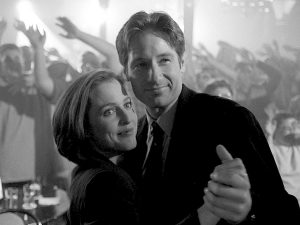
“The Post-Modern Prometheus” (1997), a quirky fifth-season episode written and directed by series creator Chris Carter, who had wanted to pen an episode inspired by Mary Shelley’s seminal SF horror story Frankenstein; or, the Modern Prometheus, and in particular, by James Whale’s 1931 film adaptation of the tale. The episode was filmed in black and white as an homage to the Whale classic.
Cher, an X-Files fan, turned down the offer to cameo in the episode—an imitator was employed in her place. “I wanted them to ask me to come on and act,” she recalled. “They just wanted me to come on and sing.” And the superstar chanteuse wasn’t interested in making such an appearance.
But then she saw the episode! Suitable impressed, she quickly changed her tune, explaining that had she anticipated the exceptional quality of the finished piece, she “would have done it in a heartbeat!”
3) What was the title of that old sci-fi flick? You know, the one where Frankenstein races against Rocky Balboa!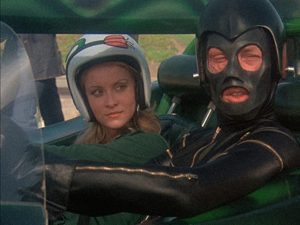
Death Race 2000 (1975) stars David Carradine as a masked race car driver dubbed “Frankenstein,” and features soon-to-be Rocky star Sylvester Stallone in an early role as rival driver “Machine Gun” Joe Viterbo. B-movie impresario Roger Corman is one of the film’s producers.
In the dystopian future of the year 2000, Frankenstein, Machine Gun Joe, and other colourfully named drivers race cross-country in souped-up cars equipped to disable, maim, and kill not only competitors, but hapless pedestrians! Bonus points are scored for hit-and-run deaths!
Sponsored by a totalitarian U.S. government exercising martial law over a land beset by economic collapse and widespread civil unrest, the violent and bloody Transcontinental Road Race is staged annually as a bread-and-circuses distraction for an uneasy populace.
A group of rebels, however, plot against the government and plan to disrupt the race and kidnap champion driver Frankenstein so as to exercise leverage over the regime. But unbeknownst to the rebels, Frankenstein is of kindred thought and has his own plan to assassinate the president and end the carnage.
4) What was the title of that original-series Star Trek episode? You know, the one with the Mugato.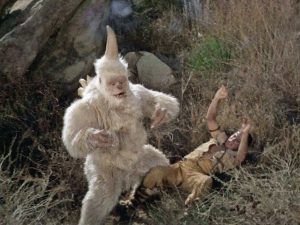
“A Private Little War” (1968), a second-season episode often interpreted as an allegory for U.S. involvement in the Vietnam War.
Gene Roddenberry would ultimately rewrite Don Ingalls’ original script, the first draft of which called the gorilla-like Mugato a Neuralese Great Ape. In later drafts the creature became a Gumato, and is so named in the episode’s closing credits.
5) What was the title of that old creature feature? You know, the one with the giant octopus that pulls down the Golden Gate Bridge!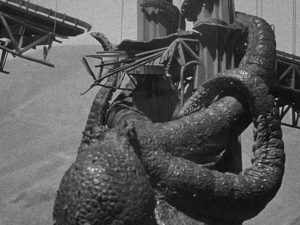
It Came from Beneath the Sea (1955), in which a titanic octopus is displaced from its natural deep-sea habitat by hydrogen bomb tests in the area. The colossal cephalopod terrorizes the Pacific, finally arriving in San Francisco to destroy the Golden Gate Bridge.
The film was a showcase for the stop-motion animation talents of Ray Harryhausen, fresh off the success of his influential 1953 giant-monster movie, The Beast from 20,000 Fathoms. In order to save time and money, Harryhausen’s monster octopus sported only six tentacles, rather that the requisite eight!
It Came from Beneath the Sea marked the beginning of his decades-long association with producer Charles H. Schneer.
6) What was the title of that old Lost in Space episode? You know, the one with the giant talking carrot!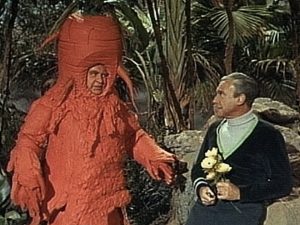
“The Great Vegetable Rebellion” (1968), a third-season episode considered by many SF TV fans as one of the most ridiculous ever produced.
Actor Stanley Adams played Tybo, the famously campy carrot-man and ruler of a planet dominated by intelligent plant life. Trek fans may recognize him as Cyrano Jones, vendor of tribbles!
Writer Peter Packer apologized to series star Jonathan “Dr. Smith” Harris for his story, saying “I didn’t have another damned idea in my head.” He wrote over 20 scripts for Lost in Space; this was his last.
7) What was the title of that old Twilight Zone episode? You know, the one where the Penguin survives a nuclear war, finds piles of books to read in the rubble of the town library, but then accidently shatters his glasses so he can’t read any of them!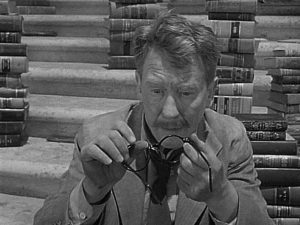
“Time Enough at Last” (1959), an early first-season episode and one of The Twilight Zone’s most celebrated. The teleplay was written by series creator Rod Serling, adapting a short story by Lynn Venable originally published in If: Worlds of Science Fiction.
The episode starred Burgess Meredith in his first of several Twilight Zone appearances. He later played arch villain The Penguin in the popular 1960s Batman TV series.
8) What was the title of that Voyage to the Bottom of the Sea episode? You know, the one where they take aboard Seaview some kind of plankton that keeps growing and growing out of control!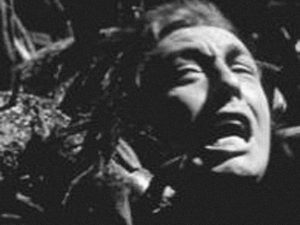
“The Price of Doom” (1964), a first-season episode written by a displeased Harlan Ellison under his pseudonym Cord Wainer Bird.
On top of dealing with the danger to Seaview of this rapidly growing and ever-expanding, bulkhead-buckling plankton, the crew must contend with an enemy agent aboard ship!
9) What was the title of that Star Trek: The Next Generation episode? You know, the one where the aliens speak in metaphors!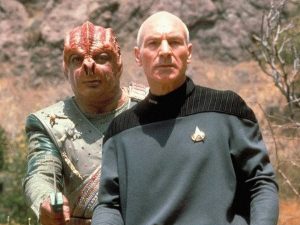
“Darmok” (1991), a fifth-season episode considered one of TNG’s, and indeed, the entire Star Trek franchise’s very best.
The aliens in the episode are called Tamarians and the Federation’s previous attempts to establish relations with them have all failed due to neither side being able to understand the other. The Enterprise is tasked with making contact with a Tamarian vessel in orbit around the planet El-Adrel IV in a fresh attempt. But as the Tamarians communicate their thoughts and emotions through allusions to their history and mythology, Picard and crew are unable to decipher their language any more than the Tamarians are able to comprehend Picard’s entreaties.
The episode’s title refers to the Tamarian phrase “Darmok and Jalad at Tanagra,” which references a Tamarian tale of two warriors who met on the island of Tanagra and united to battle a deadly beast, thus forging a friendship through shared adversity. The orchestrated situation in which Picard soon finds himself with the Tamarian captain, Dathon, on the planet’s surface is similar, and Picard begins to understand how the Tamarians communicate.
When Dathon is wounded battling their shared beastly adversary, Picard tends to his injuries and is eventually able to communicate with Dathon by recounting to him the Epic of Gilgamesh, an Earth legend not unlike the Tamarian captain’s own Darmok and Jalad at Tanagra.
Dathon, unfortunately, succumbs to his wounds and Picard returns to the Enterprise just in time to avoid sparking an unintended war with the Tamarians. Dathon will be remembered by his people as the first to successfully establish communication with the Federation in what they will henceforth term Picard and Dathon at El-Adrel.
10) What was the title of that old dinosaur movie? You know, the one on an island where the guy fights a Tyrannosaurus rex with a mechanical excavator!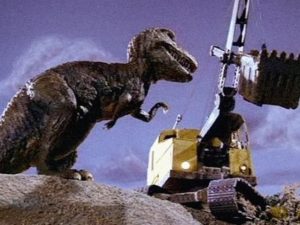
Dinosaurus! (1960), in which a Brontosaurus and a Tyrannosaurus rex, preserved for millions of years in icy suspended animation, are uncovered at the bottom of the harbour bay that a construction crew are dredging on a remote Caribbean island. Pulled up onto the beach, a bolt of lightning during a nighttime storm reanimates the prehistoric titans and they are soon roaming about the island wreaking havoc, culminating in the dinosaur-versus-excavator duel on a cliff side.
The team of producer Jack H. Harris and director Irvin Yeaworth, who had made The Blob two years earlier, offered the lead role to their Blob star, Steve McQueen, but he passed on the opportunity to, instead, appear in a Western, The Magnificent Seven.
Stop-motion and puppetry were employed to bring the dinosaurs to life on screen.
11) What was the title of that original-series Jonny Quest episode? You know, the one with the prehistoric Pteranodon!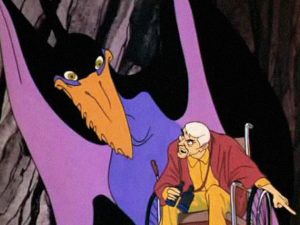
“Turu the Terrible” (1964), in which a wheelchair-bound villain has trained a living Pteranodon called Turu to terrorize and kill. He has tasked the creature with guarding a group of Amazon-jungle natives he has enslaved to mine what he believes to be silver, but which is actually a high-grade deposit of the rare metal, trinoxide. According to Dr. Quest, trinoxide is essential to the space program.
While the natives call the Pteranodon “Turu,” meaning “bird,” the name given the creature by its master is, in fact, “Tulu,” the “L” being a sound the natives cannot properly pronounce. The region in which Turu roams, and trinoxide is to be found, is referred to as “The Land of the Turu.”
The villain and his pet flying reptile meet their end in a tar pit, but Turu lives on, in a manner of speaking, appearing in each episode of the series during the opening-titles montage and closing-credits sequence.
12) What was the title of that Wonder Woman TV episode? You know… The show starred Lynda Carter… It was the episode that introduced Wonder Woman’s younger sister, Wonder Girl!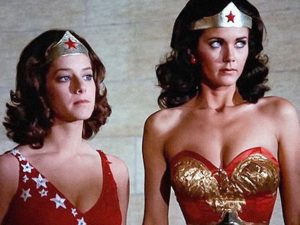
“The Feminum Mystique” (1976), a first-season two-parter, is notable in that it introduces Diana Prince/Wonder Woman’s younger sister, Drusilla, who arrives from Paradise Island to visit Diana in Washington and becomes entangled in a Nazi plot to steal the U.S. Army’s first jet fighter, shortly to be unveiled.
Drusilla assumes the mantle of Wonder Girl and in Part II, helps her big sister thwart a Nazi invasion of Paradise Island in order to compel the Amazons to mine Feminum ore, the metal used to fashion Wonder Woman’s bullet-proof bracelets. Then the two return to Washington to foil the theft of the new jet. All in a day’s work for these two Amazon princesses!
In one of her earliest roles, newcomer Debra Winger played Drusilla/Wonder Girl. The character appeared again later that same season in “Wonder Woman in Hollywood.”
13) I remember this one episode of the Buck Rogers in the 25th Century TV series… There was a spaceship that looked like Montreal’s Olympic Stadium, flipped over! And Catwoman was the villain! What was the title of the thing, again?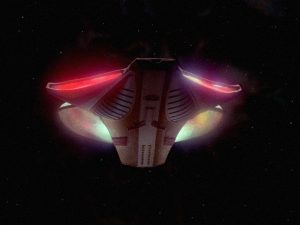
“Flight of the War Witch” (1980), a two-hour adventure, capped the series’ first season and featured Julie “Catwoman” Newmar as the titular War Witch.
Travelling through a mysterious vortex to another universe, Buck and Princess Ardala form an uneasy alliance in order to defeat the pitiless War Witch, Zarina, she the evil Zaad ruler threatening the helpless Pendarans, who have appealed to Buck for help.
Zarina’s flagship is a Zaad Battle Cruiser, the design of which was clearly inspired by Montreal’s Olympic Stadium and Tower, turned upside down!
12) THANK YOU!
We hope you have enjoyed your time with us this afternoon, we thank you for dropping in, and we ask all of you to check in regularly here at www.MonSFFA.ca for additional content during this continuing-but-seemingly-winding-down pandemic, and for any updates as to when the club expects a return to regular, face-to-face meetings. Thank you for your interest and attention, and don’t forget to comment on today’s e-meeting!
We’d like to acknowledge the efforts of Keith Braithwaite and Cathy Palmer-Lister with regard to today’s programming, and thank, as well, all supporting contributors to what has been our March 2022 e-meeting.
13) SIGN-OFF
And so, farewell until we meet again right here at www.MonSFFA.ca on Saturday, April 9, for another in our ongoing series of MonSFFA e-meetings! Peace.
The bracket cards we’ve used this meeting illustrate the show of support expressed by cities around the world for embattled Ukraine.
Slava Ukraini!
Post 7 of 8: Sci-Fi Balderdash, Sorta, Kinda…
10) Sci-Fi Balderdash, Kinda, Sorta
We’ll be on Zoom for the next half-hour playing a sci-fi version of Balderdash, kinda, sorta! For you non-Zoomers, here’s a taste of what we have planned in the coming months:
First of all, we’re working on booking a couple of guest speakers, one who will talk astronomy, the other speaking on selling your SF/F “fancraft” on Etsy. We’ll confirm dates as soon as we have that all figured out.
Also, we have a presentation planned on the brief Hollywood career of artist and sculptor Paul Blaisdell, fondly remembered by fans of mid-century sci-fi cinema for his memorably outlandish B-movie creatures.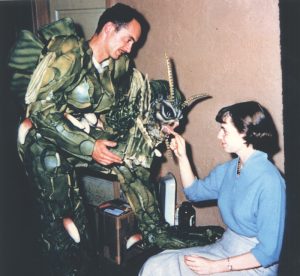
In the mid-1950s, Blaisdell earned a reputation among independent genre film producers like Roger Corman for quickly designing and cheaply fabricating movie monsters, leading to his rapid rise and brief reign as the go-to monster-maker among Hollywood’s low-budget sci-fi/horror filmmakers. Often donning his monster suits to play the beasts on screen, Blaisdell’s special effects work was too frequently uncredited, and just as quickly as he rose within the industry, the rapacious nature and changing fortunes of the movie business conspired to drive a disillusioned Blaisdell entirely out of the entertainment field by the early 1960s, never to return.
Today, his then-largely unsung contributions to the field are acknowledged and heralded by modern Hollywood.
We’ll examine, too, the brief history of Canada’s own weird fiction/sci-fi magazine, Uncanny Tales, not to be confused with the American periodical of the same name.
During World War II, the Canadian government introduced the War Exchange Conservation Act (WECA), restricting trade in non-essential goods in order that, as much as possible, Canadian dollars be held in reserve within Canada to support the war effort. Among the products barred from importation were the popular American comic books and pulp magazines of the day, prompting Canadian publishers to seize an opportunity and fill suddenly empty newsstand shelves with homegrown alternatives.
Birthed during this period were a cavalcade of Canadian comic book crime-fighting adventurers and superheroes like Canada Jack, Nelvana of the Northern Lights (pre-dating Wonder Woman), Iron Man (pre-dating by more than two decades the Marvel Comics character of the same name), Captain Wonder, Cosmo, and many others.
Most notable of the science fiction and fantasy pulps resulting from this unique Canadian publishing phenomenon was Uncanny Tales, boasting not merely the reprinted stories of American and British writers, but fresh fiction penned by Canadians.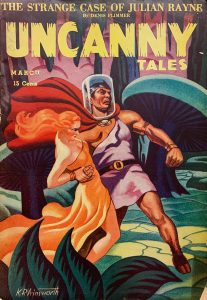
A colourful, Toronto-based middleweight-boxer-turned-scribe named Thomas P. Kelley, who fashioned himself “King of the Canadian Pulp Writers,” was the most prolific of these authors. Under his own name and numerous pseudonyms, he would, aided by his wife, Ethel, regularly write a couple or more stories per day, some 100,000 words a week! He provided almost all of the content featured in the early issues of Uncanny Tales!
Uncanny Tales and its contemporaries flourished but their success was short-lived, most of the magazines folding when the trade embargo was lifted after the war ended and American titles returned to newsstands. History has been kind to the Canadian superhero comic books that the WECA era spawned, not so much the pulp magazines, which were not as well regarded. Today, surviving copies of these so-called “CanPulps” are rare and greatly valued among collectors.
At some point, we expect to return to our regular, in-person meetings, but at the moment, we don’t know when that will happen. Note that we do plan to continue with these online gatherings in conjunction with the eventual resumption of our live-and-face-to-face get-togethers.
Coming up momentarily at 4:45PM is the final post of this virtual meeting; answers to the opening Quickie Quiz will be revealed, and our next e-meeting date announced.